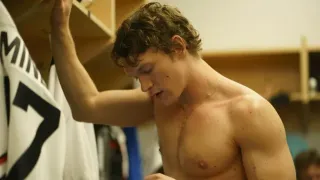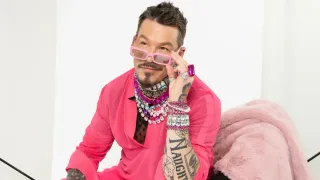March 13, 2024
Actor Sean Leviashvili Finds Authenticity in SpeakEasy's 'Cost of Living'
Kilian Melloy READ TIME: 8 MIN.
SpeakEasy Stage Company brings Martyna Majok's Pulitzer Prize-winning play "Cost of Living" to Boston in a production directed by Alex Lonati. Set against a backdrop of economic inequality, the play is an exploration of how hearts and bodies alike can face challenges that erase what once was – or open up to new potential.
The story spotlights two relationships. Eddie (Lewis D. Wheeler) and Ani (Stephanie Gould) are a longtime couple whose bond collapsed not long before a life-altering accident left Ani paralyzed. Now the former life partners struggle to salvage what's left and, possibly, build a new future.
Meanwhile, John (Sean Leviashvili), a Ph.D. candidate at Princeton and the son of a wealthy family, sets about hiring a home health aide. John has cerebral palsy, a neuromotor condition that, in his case, is debilitating. He needs assistance with personal grooming such as shaving, bathing, and getting dressed. John hires Jess (Gina Fonseca), a first-generation immigrant whose smarts and drive got her an Ivy League education of her own, but whose prospects are much more limited. Both are hard-headed and a touch abrasive, but as they warm up to each other new possibilities seem about to unfold.
EDGE chatted with Leviashvili about the role of John. A queer actor with cerebral palsy, Leviashvili is a graduate of Northeastern whose career has taken him to NYC and LA, seen him write, direct, produce, and star in the short film "Limp," and work on the production of shows as varied as "My Crazy Sex," "Smile," "White Water Summer," and "Below Deck Adventure."
Sean shared his insights about what the play has to say about class, disability, love, life, and the costs those things entail.
EDGE: Tell me about your character, John.
Sean Leviashvili: I believe John has the biggest story arc in this play, and that's why I'm really excited and honored to play him. The first scene [he's in] is the first day of the rest of his life: He's getting to pick his aide, who's going to help him be the best version of himself in this brand-new chapter at Princeton as a Ph.D. student. He picks this girl who's kind of edgy.
The second scene that he's in, in a weird way, it's his coming out. He's getting the chance to explain how his body works to someone new. Explaining his body is his way of revealing who he is. Then the shower scene, that is his chance to test drive skills he has never been able to before – and by that, I mean the flirting.
EDGE: Speaking of the showering scene, the stage directions are for you to be nude on stage. Was that uncomfortable for you?
Sean Leviashvil: There is a small edit there, where I'm going to be in a sheer covering over my private parts – but I still am going to have to be mostly nude. I'm learning to get comfortable with it. We have a partial shower that's constructed so that I'm not going to be fully exposed. You know, my family's coming to this and, um, they haven't seen this since, you know, I was two years old. I'd like to keep it that way for now.
[Laughter]
But more than the partial nudity, we've worked with an occupational therapist to learn what is the right step-by-step routine to properly shower someone like John. We are working to make this scene be authentic and comfortable for everyone involved. Luckily, I have this this amazing scene partner, Gina Fonseca. She has been wonderfully patient and incredibly attentive.






